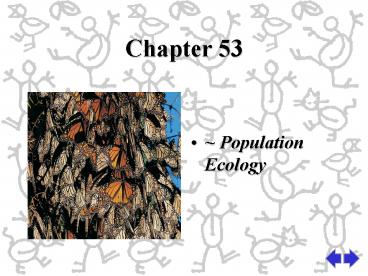~ Population Ecology - PowerPoint PPT Presentation
1 / 12
Title:
~ Population Ecology
Description:
Chapter 53 ~ Population Ecology Changes to population size Adding & removing individuals from a population birth death immigration emigration Population ... – PowerPoint PPT presentation
Number of Views:227
Avg rating:3.0/5.0
Title: ~ Population Ecology
1
Chapter 53
- Population Ecology
2
Changes to population size
- Adding removing individuals from a population
- birth
- death
- immigration
- emigration
3
Population characteristics
- Density of individuals per unit of area
counts sample size estimate
indirect indicators
mark-recapture - Dispersion pattern of spacing random
unpredictable, patternless spacing (a)
clumped patchy aggregation (b)
uniform even spacing (c)
4
Demography factors that affect growth decline
of populations
- Birthrate (natality, fecundity) of offspring
produced - Death rate (mortality)
- Age structure relative number of individuals of
each age - Survivorship curve plot of numbers still alive
at each age
5
Population Growth Models
- Exponential model (red) idealized population in
an unlimited environment (J-curve) r-selected
species (rper capita growth rate) - Logistic model (blue) carrying capacity (K)
maximum population size that a particular
environment can support (S-curve) K-selected
species
6
Carrying capacity
- Can populations continue to grow exponentially?
- of course NOT!
- what sets limit?
- resources, predators, parasites
- Carrying Capacity (K)
- maximum population size that environment can
support with no degradation of habitat - not fixed varies with changes in resources
7
Model of growth
- Decrease in rate of growth as reach carrying
capacity
8
Population life history strategies
- r-selected (opportunistic)
- Short maturation lifespan
- Many (small) offspring usually 1 (early)
reproduction no parental care - High death rate
- K-selected (equilibrial)
- Long maturation lifespan
- Few (large) offspring usually several (late)
reproductions extensive parental care - Low death rate
9
Different life strategies
- K-selection
- r-selection
K-selection
mortality constant
r-selection
10
Population limiting factors
- Density-dependent factors competition
predation stress/crowding
waste accumulation - Density-independent factors weather/climate per
iodic disturbances
11
Age structure
- Relative number of individuals of each age
What do the data imply about population growth in
these countries?
12
Human population
2005?6 billion
- What factors have contributed to this exponential
growth pattern?
1650?500 million































